Go to All Blogs | Birding Blogs | Antarctica Birding Tours | All our birding tours
Text and photographs by Dominic Rollinson
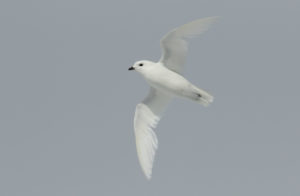
In this blog I take a closer look at the area south of 35oS as far as the Great White Continent and between the longitudes of 50oW and 20oE. This massive area is generally not an area which many birders get the opportunity to visit, but for those lucky enough to make it there the albatrosses, penguins and subantarctic island endemics will make the long (and often rough) journey well worth it. The area is not known for a large diversity of birds; however, to see such iconic birds as Emperor Penguin, Snow Petrel, and Wandering Albatross one simply has to visit the area.
The easiest way for tourists to visit Antarctica and the subantarctic islands is to leave onboard a cruise ships from the Argentinean town of Ushuaia. The standard tour usually includes the Falkland Islands (Islas Malvinas), South Georgia, and the Antarctic Peninsula (see here ), which all offer their own unique species and scenery.
The first stop on an Antarctic cruise is the Falklands Islands, which are currently a British overseas territory. However, their sovereignty status has been controversial, with both Britain and Argentina claiming ownership. The islands’ birdlife is similar to Patagonia, sharing a large degree of overlap in the terrestrial species, with only two endemic bird species, Cobb’s Wren and Falklands Steamer Ducks. However, the Falklands are not visited for their terrestrial bird diversity but rather for their impressive seabird colonies. They are of particular conservation importance for their huge populations of Black-browed Albatross and Southern Rockhopper and Gentoo Penguins. Having evolved with very few land predators, many of these birds allow tourists to approach to point-blank levels, and so care should be taken to not provide undue disturbance to nesting birds.
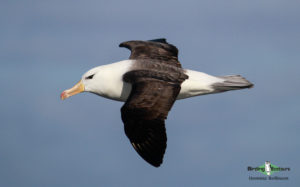
While meandering along the coastline of the islands you are likely to encounter a number of waterfowl species including Upland, Kelp, and Ruddy-headed Goose, while the endemic Falkland Steamer Duck can be seen without too much difficulty. Keep a lookout for raptors such as Turkey Vulture and Southern Crested Caracara, particularly on the edge of seabird colonies, on the hunt for vulnerable chicks and eggs. Along the coastline you are likely to come across South American Tern and Kelp and Dolphin Gulls as well as an assortment of South American waders. Of the passerines Cobb’s Wren, Blackish Cinclodes, and Black-throated Canary are the most important targets and can all be found with relative ease. Correndera Pipit, Austral Thrush, Long-tailed Meadowlark, and Dark-faced Ground Tyrant can also be seen in good numbers while traversing the islands. Three species of pinnipeds breed on the Falklands, South American sea lion being the most abundant, with smaller numbers of South American Fur Seal and Southern Elephant Seal.
While moving between the various islands of the archipelago you are likely to see large numbers of seabird species, many of which you may not have seen on land due to the remoteness of their breeding colonies. Experiencing Procellariiformes (albatrosses, petrels, shearwaters, and storm petrels) and penguins at sea really makes you appreciate just what they were designed for; a life at sea. Although close-up views of these birds on their breeding islands allows you to appreciate the beauty of their plumage and complexity of their bills, nothing will compare to watching the three-meter wingspan of a Wandering Albatross effortlessly cruising around your ship, or watching the high-arcing flight of a Pterodroma petrel in gale force winds.
Some of the seabirds to be expected at sea around the Falklands include Wandering, Northern Royal, Southern Royal, and Grey-headed Albatrosses, Southern and Northern Giant Petrel, Cape and White-chinned Petrels, Sooty and Great Shearwaters, Slender-billed and Fairy Prions, as well as Grey-backed Storm Petrel, which is essentially restricted to the waters surrounding a limited number of subantarctic islands. There should also be a number of penguins seen around, including the likes of Gentoo, Southern Rockhopper, and Magellanic Penguins, with smaller numbers of Macaroni Penguins. Cetaceans are well represented in these waters, with Orcas regularly encountered as well as a number of rare and lesser-known dolphin species including Peale’s, Hourglass, Commerson’s, and Southern Right Whale Dolphins.
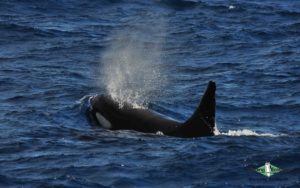
Next on the itinerary of an Antarctic cruise from Ushuaia is South Georgia. This large, glaciated island was the endpoint of Sir Ernest Shackleton’s epic rescue mission and ultimately the final resting place for Shackleton himself. The island consists of dramatic peaks and glaciers with huge numbers of breeding seabirds. There is one endemic bird species, the South Georgian Pipit, which is the most southerly breeding passerine in the world!
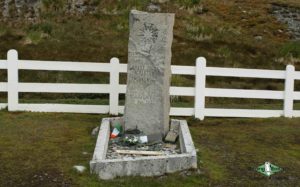
In recent years the pipits have become easier to see, as the island has been rat-free since a successful eradication in 2015, and can now be seen at a number of locations throughout the mainland, being formerly restricted to a small number of rat-free islands. Other terrestrial species to look out for include Yellow-billed Pintail (endemic South Georgian subspecies), Speckled Teal (low numbers), South Georgian Shag (restricted to South Georgia, South Sandwich, and South Orkney), and Snowy Sheathbill. The latter can frequently be seen along the edge of the large penguin colonies, feeding on scraps and small chicks. Antarctic Tern and Kelp Gull (subantarctic subspecies) can be seen in the many bays throughout the island.
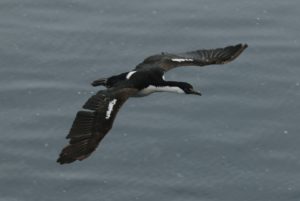
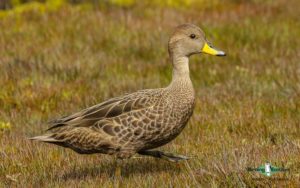
South Georgia is probably best known for its massive colonies of penguins, of which Macaroni Penguin is the most numerous (an estimated 5.4 million pairs!), with smaller numbers of King Penguin (around 400 000 pairs) along with Gentoo and Chinstrap Penguins. Albatrosses are well represented on the mainland and smaller islands with globally significant numbers of Wandering Albatross as well as Black-browed, Grey-headed, and Light-mantled Albatrosses. The beautiful Light-mantled Albatross breeds on steep cliffs, and their presence is often given away by their high-pitched screams. Both Southern and Northern Giant Petrels breed on the island and can be seen in large congregations scavenging on animal and bird carcasses.
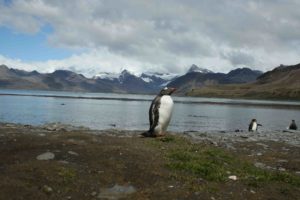
A large number of the smaller tubenoses (Procellariiformes excluding albatrosses) breed on the island; however, with all being burrow-nesters they are not regularly encountered on land as they often only return to the island after dark, when the predation threat from Brown Skuas is reduced. While moving around the island between the many sheltered bays you are likely to come across Antarctic and Fairy Prion, Blue Petrel, Wilson’s, Black-bellied, and Grey-backed Storm Petrels, and Common and South Georgian Diving Petrels, which can pose a significant identification challenge.
Some of the tourist attractions on South Georgia include the old whaling station of Grytviken within Cumberland Bay. From here you can visit Shackleton’s grave while constantly dodging angry Antarctic Fur Seals and Southern Elephant Seals!
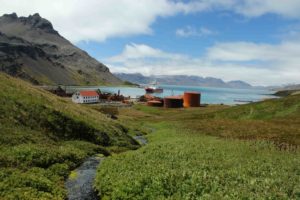
Heading southwest toward the Great White Continent some cruises stop off at the South Orkney Islands. Having moved significantly closer to the continent, icebergs are a common feature on the horizon and can provide for some dramatic photographic opportunities. Adelie and Chinstrap Penguins are the most abundant penguins on these islands; however, smaller numbers of Gentoo and Macaroni Penguins also occur. The most abundant tubenose is the Southern Fulmar, which may number up to one million pairs, with similarly huge numbers of Antarctic Prion. The beautiful Cape (or Pintado, meaning “painted” in Spanish) Petrel breeds in good numbers here too, while no trip to Antarctica would be complete without views of the iconic Snow Petrel, which number around 1000 pairs. The islands hold important numbers of Snowy Sheathbill as well as smaller numbers of both South Polar and Brown Skuas as well as Antarctic Shag.
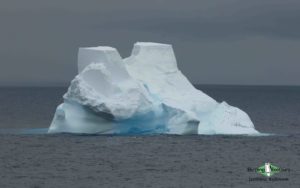
The South Shetland Islands and the Antarctic Peninsula are usually the next stops on an Antarctic cruise and provide opportunities to witness impressive geological features such as volcanic craters as well as massive glaciers. The area supports large numbers of whales, which spend their summers feasting on the area’s krill-rich waters, including Sei, Fin, Humpback, Antarctic Minke and Sperm Whales. The area has a high diversity of seals, and Antarctic fur, Southern Elephant, and Weddell Seals can all be seen relatively easily. Crabeater and Leopard Seals often require a bit more effort; vigilantly scanning for animals hauled out on the ice flows often produces sightings. For those cruises which venture further south along the Peninsula a careful eye should be kept out for the mega-rare Ross’s Seal, which only occurs right down south and in low numbers.
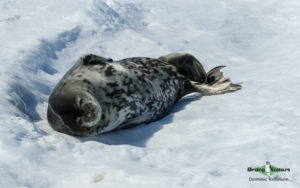
As is to be expected, large numbers of penguins breed on the South Shetland Islands and on the Antarctic Peninsula, including Adelie, Chinstrap, Gentoo, and Macaroni Penguins. As might not be expected, Emperor Penguins are rarely encountered on Antarctic cruises, as the only colony in the region is off limits to visitors. However, you may just get lucky with a stray penguin or two!
Although few albatrosses breed this far south, Light-mantled, Grey-headed, and Black-browed are regularly encountered in the northern Peninsula region. Tubenoses are well represented and include Southern Giant, Cape, and Snow Petrels, Southern Fulmar, Antarctic Prion, and Wilson’s Storm Petrel (several million pairs). Antarctic Petrels are suspected to breed in the region and can be seen in large numbers, sometimes in feeding flocks into the hundreds. Antarctic Shags can be seen breeding on rocky outcrops and cliffs. Both South Polar Skua and the similar Brown Skua occur throughout the Peninsula, while most of the world’s Antarctic Tern population breeds on the South Shetland Islands.
Moving further east along the Antarctic Continent to areas far off the tourist agenda will give you the opportunity to visit an Emperor Penguin colony. Visiting such a colony is a privilege to experience and one that very few people ever get the chance to do. Antarctic and Snow Petrels breed on the continent’s many mountain ranges, with South Polar Skuas being the only skua occurring in these areas. Unfortunately just about the only way to visit these areas is onboard a scientific expedition.
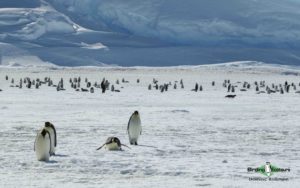
Another area rarely visited by tourists, however, has seen a few tourist visits over the years, the South Sandwich Islands, which lie to the east-southeast of South Georgia. This chain of volcanic islands has shown recent volcanic activity and provides scenic views with an assortment of bird species. The islands are memorable for their tall rock stacks, which are dotted white with breeding Snow Petrels. The bird diversity is similar to the South Orkney Islands, but Antarctic Shags are replaced by South Georgian Shags and the islands lack South Polar Skua and Snowy Sheathbill.
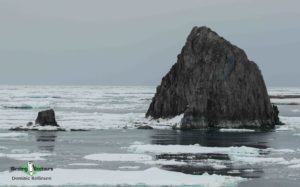
Heading further off the tourist map and about 2500 km east takes you to Bouvet Island; the world’s most remote island. The island is of Norwegian dependency and is uninhabited; the only humans who ever get to land on this island are scientific teams, which sporadically visit the island to study its wildlife. The island supports large colonies of seabirds with the largest populations being Macaroni Penguin and Southern Fulmar. Smaller numbers of Adelie and Chinstrap Penguins occur; however, their populations appear to have been kept in-check by the increasing numbers of Antarctic Fur Seals and Southern Elephant Seals. Tubenoses breeding on the island include Snow and Cape Petrels, Southern Giant Petrel, Antarctic Prion, and Wilson’s Storm Petrel. Birds likely to be seen in the nearby waters include Wandering, Black-browed, Grey-headed, and Light-mantled Albatrosses as well as an assortment of Petrels, including Antarctic, Blue, Kerguelen, White-headed, and Soft-plumaged.
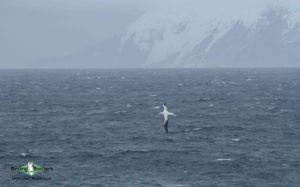
Back onto the tourist track and approximately 2200 km north-northwest takes you to the archipelago of Tristan da Cunha. The archipelago consists of four islands (Tristan da Cunha, Nightingale, Inaccessible, and Gough), of which only Tristan da Cunha is permanently inhabited, making it the most remote permanent settlement on earth. Tristan da Cunha can be accessed onboard vessels which leave from Cape Town a few times a year. Accessing the other islands is trickier; however, once on Tristan da Cunha access to Nightingale and Inaccessible can be arranged through the Tristan Conservation Department. But bad weather can make these landings impossible at certain times of the year. Getting to Gough Island is equally difficult, as it lies approximately 450 km southeast of Tristan da Cunha. However the RMS St Helena does visit the island with some frequency.
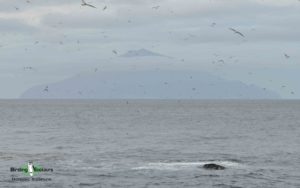
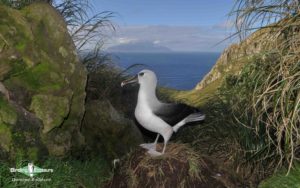
The archipelago does host a number of endemics, including Tristan and Atlantic Yellow-nosed Albatrosses, Spectacled and Atlantic Petrel, Inaccessible Island Rail, Gough Moorhen, Tristan Thrush, and four species of Finches (Gough, Inaccessible Island, Nightingale Island, and Wilkins’s). The archipelago also contains globally significant populations of Northern Rockhopper Penguin, Sooty Albatross, and Kerguelen Petrel as well as Broad-billed and MacGillivray’s Prion. Subantarctic Fur Seals breed on all of the archipelago’s islands, while Southern Elephant Seals regularly haul out on the island’s stony beaches.
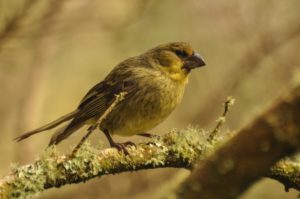
The main island of Tristan da Cunha is the largest in the archipelago and also the most impacted by man. A number of species have become extinct or dramatically reduced on Tristan da Cunha due to their being harvested for food by the Tristanian population or to the devastating impact of introduced predators. Therefore many of the seabirds and terrestrial species are much easier to see on the smaller islands. Despite this Tristan da Cunha does offer some good birding and is the easiest place to find Gough Moorhen. The moorhens seen on Tristan da Cunha are all likely to be birds introduced from Gough Island, with the native Tristan Moorhen thought to have been exterminated by the end of the 19th century! A hike up onto the plateau should reward you with (normally fleeting) glimpses of the Gough Moorhen, with Atlantic Yellow-nosed Albatross breeding between the tussac grass and ferns, while Sooty Albatross can be seen on the cliffs. Tristan Thrush can also be seen on Tristan da Cunha; however, it is not easy. Antarctic Terns occur along the coastline, with a small number of Brown Skuas (Tristan subspecies) still breeding. Offshore of Tristan da Cunha you are likely to come across Great-winged, Kerguelen, Atlantic, Grey, and Spectacled (from nearby Inaccessible Island) Petrels, Great, Sooty, and Subantarctic Shearwaters, Broad-billed Prion, and Common Diving Petrel as well as White-bellied, Black-bellied, and White-faced Storm Petrels. Care should be taken when differentiating the two Fregetta storm petrels in the area; a subspecies of Black-bellied Storm Petrel occurs on these islands that does not show the black belly, and therefore more subtle plumage features are required to differentiate it from White-bellied Storm Petrel!
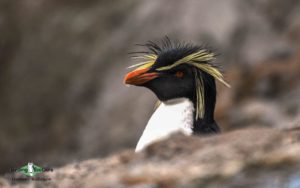
Approximately 30 km south-southeast of Tristan da Cunha lies the tiny uninhabited island of Nightingale. Upon landing you are normally quickly investigated by the inquisitive Tristan Thrush, which is abundant throughout the island, often following you as you move around. The two most important species to see here are Nightingale Island and Wilkins’s Finches, which are both endemic to Nightingale Island. Nightingale Island Finch can be seen easily on the lower sections of the island among the tussac grass, while Wilkins’s Finch only occurs in the higher areas in the Phylica woodland and is not difficult to see there, despite its low numbers (50 – 100 pairs!). Atlantic Yellow-nosed Albatrosses breed throughout the island, and care needs to be taken not to scare them off their nests because hungry Brown Skuas and Tristan Thrushes are never too far away. Sooty Albatrosses breed on the island’s many steep cliffs, with their high-pitched screams a familiar sound throughout the island. The island has huge numbers of primarily Great Shearwater and Broad-billed Prion, which return to their breeding burrows in the early evening in the millions. Other tubenoses breeding on the island but seen less frequently during the day include Soft-plumaged Petrel, Common Diving Petrel, Subantarctic Shearwater, and Black-bellied, White-bellied, and White-faced Storm Petrels. Small numbers of Antarctic Tern and Common Noddy breed, while the island hosts a large Northern Rockhopper Penguin colony.

Inaccessible Island lies about 20 km to the northwest of Nightingale Island and is considerably larger. Although landings are difficult they are not as impossible as the name might suggest! The biggest attraction here is the almost mythically Inaccessible Island Rail, which is the smallest flightless bird in the world! There are thought to be around 8400 individuals on the island which occur in high densities; as such the birds are not difficult to see. The Inaccessible Island Finches number around 10 000 pairs and occur in three different subspecies. These occupy different altitudes and habitats throughout the island and do not pose much of a challenge to see. The last endemic, Spectacled Petrel, numbers roughly 14 000 pairs on Inaccessible and can be seen at sea throughout the archipelago. Encouragingly their numbers have been steadily increasing in recent years since the removal of feral pigs in 1930. Additional to those seabirds breeding on Nightingale Island, Inaccessible also has Kerguelen Petrel and possibly Great-winged, Grey, and Atlantic Petrels, while two to three pairs of Tristan Albatross breed most years and can occasionally be seen following fishing vessels in the vicinity.
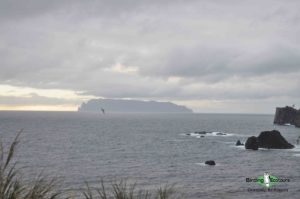
The last of the islands in the archipelago is Gough Island, which is a full day’s steam southeast of Tristan da Cunha. Gough Island hosts a small scientific team that changes each year. The most important bird to see on Gough Island is the Gough Finch, which numbers around 1000 pairs and can be seen fairly easily on the island. The purists may want to find Gough Moorhen on its natural island; these birds number around 3500 pairs and similarly do not pose too much difficulty in seeing them. Tristan Albatross breed at altitudes of 400-700 meters on Gough and number 1250 – 1750 pairs. Their numbers have been impacted at sea by drowning on long lines, while breeding success has been worryingly low due to the accidental introduction of house mice by sealers in the late 19th century. Thankfully there is a plan to eradicate the mice from Gough Island that is due to begin in 2019; all going well the island will be mouse-free by 2021! All prions on the island should be checked carefully, as a population of MacGillivray’s Prion was discovered to occur alongside the more numerous Broad-billed Prion as recently as 2012. Before this population was discovered MacGillivray’s Prion was only known from St Paul Island in the Indian Ocean, where as few as 100 – 200 pairs persist. MacGillivray’s Prion can be told apart with difficulty from Broad-billed Prion; however, the slightly thinner bill with blue-grey sides and tip compared to the broader all black bill of Broad-billed Prion should clinch the identification. Large populations of Kerguelen, Atlantic, Grey, Soft-plumaged, and Great-winged Petrels breed on Gough Island, and Gough is the only island in the archipelago to support breeding populations of Southern Giant and Blue Petrels (only discovered breeding in 2014!).
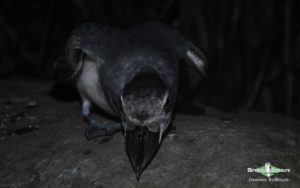
The remoteness of these subantarctic islands makes many of them difficult to access. This remoteness, however, has kept them largely uninhabited and therefore to the most part pristine. Having evolved without the presence of land predators, most of their birds allow for close-up views as well as the opportunity to observe fascinating courtship displays and other interactions. For the serious lister these places do not offer a great deal of bird diversity, but the quality of the birds and often the staggering numbers will leave you yearning to come back.
